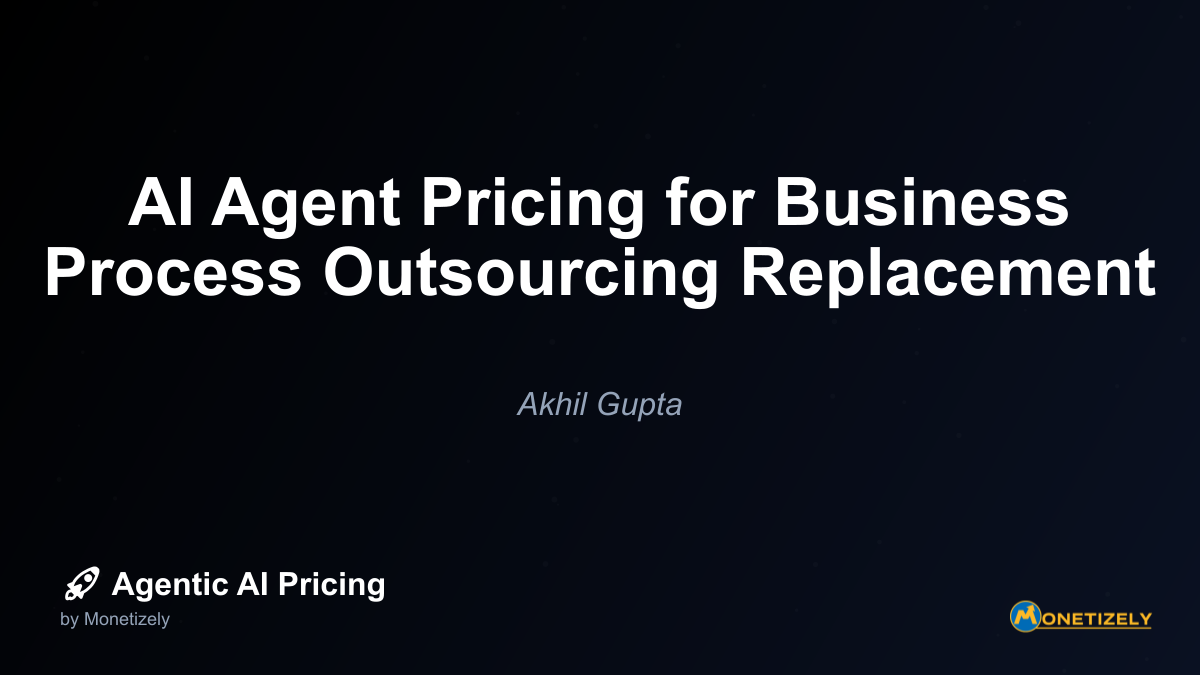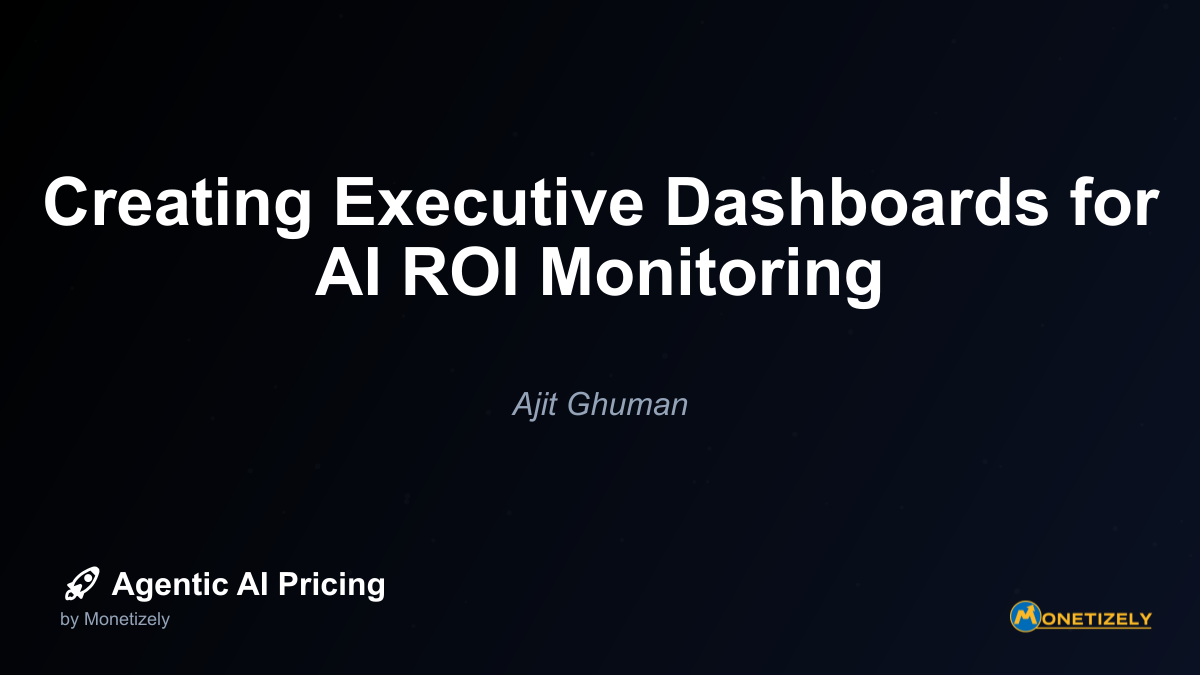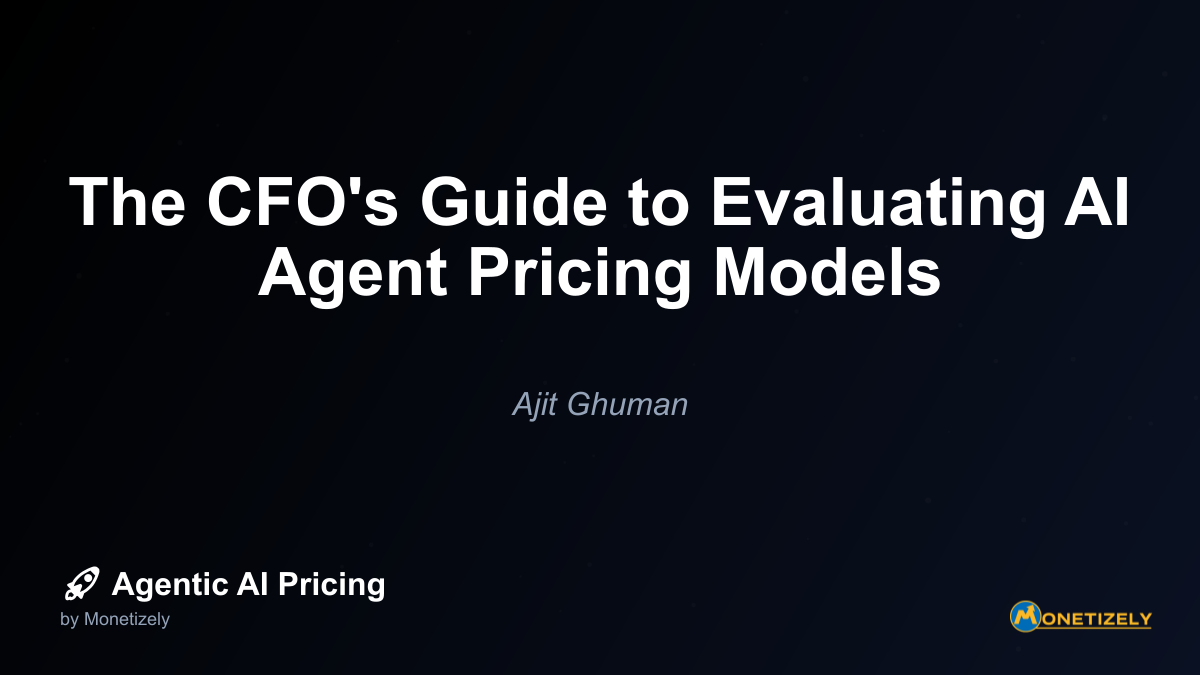· Ajit Ghuman · ROI and Value · 10 min read
Investor Perspectives: Demonstrating AI ROI to Stakeholders.
AI and SaaS Pricing Masterclass
Learn the art of strategic pricing directly from industry experts. Our comprehensive course provides frameworks and methodologies for optimizing your pricing strategy in the evolving AI landscape. Earn a professional certification that can be imported directly to your LinkedIn profile.

Demonstrating the value of artificial intelligence investments to stakeholders has become a critical skill for executives as AI transitions from experimental technology to essential business infrastructure. For companies implementing agentic AI solutions, communicating ROI effectively can mean the difference between continued investment and stalled innovation initiatives.
Board members and investors increasingly demand concrete evidence that AI deployments contribute meaningfully to enterprise value rather than serving as costly technological experiments. This requires a structured approach to measurement, analysis, and communication that speaks directly to stakeholder concerns while highlighting both immediate returns and strategic positioning advantages.
The Evolving Investor Perspective on AI
Investor attitudes toward artificial intelligence have undergone significant evolution over the past decade. Initially viewed as speculative technology with uncertain returns, AI has increasingly become an expected component of forward-looking business strategy. This shift brings both opportunities and challenges for leadership teams.
From Experimental to Essential
Early AI investments often received latitude from investors who recognized the experimental nature of the technology. Today, that grace period has largely ended. According to recent market analyses, over 76% of institutional investors now expect quantifiable returns from AI initiatives within 12-24 months of implementation, compared to just 35% in 2018.
This acceleration in expectations reflects AI’s maturation. As one venture capital partner recently noted, “We’ve moved past the ‘AI for AI’s sake’ era. Today’s investors want to see how these technologies translate to competitive advantage and bottom-line impact.”
The Dual Lens: Short-Term Returns and Strategic Positioning
Modern stakeholders evaluate AI investments through two distinct but complementary lenses:
- Near-term operational improvements: Measurable efficiency gains, cost reductions, and revenue enhancements directly attributable to AI implementation
- Strategic competitive positioning: How AI capabilities differentiate the company, create barriers to entry, and position it favorably for future market developments
Successful ROI communication addresses both perspectives, acknowledging immediate returns while articulating how current investments establish foundations for sustained competitive advantage.
Essential Metrics for Demonstrating AI ROI
Effective stakeholder communication begins with selecting the right metrics—measurements that resonate with investor priorities while accurately reflecting AI’s business impact.
Financial Impact Metrics
Financial metrics provide the most direct connection to investor interests, translating technical capabilities into language that resonates with shareholder value creation:
- Revenue attribution: Incremental revenue directly attributable to AI implementations
- Cost reduction: Operational savings from automation, optimization, and improved decision-making
- Margin expansion: Improvement in profit margins resulting from AI-driven efficiencies
- Return on AI investment (ROAI): Calculated as (Financial benefits - AI costs) / AI costs
- Time to value: Duration between investment and measurable financial returns
When presenting these metrics, contextualizing them against industry benchmarks significantly enhances their impact. For example, rather than simply reporting a 15% cost reduction in customer service operations, frame it against the industry average of 8-10%.
Operational Metrics
Operational metrics demonstrate how AI transforms business processes, often serving as leading indicators for financial performance:
- Productivity improvements: Output per employee or team
- Process cycle time reduction: Acceleration of key business processes
- Quality improvements: Reduction in errors or defects
- Decision velocity: Acceleration in time-to-decision for key business determinations
- Resource utilization: Optimization of expensive assets or resources
These metrics can be particularly compelling when presented as trend lines showing continuous improvement as AI systems learn and evolve over time.
Customer Impact Metrics
Customer-focused measurements demonstrate how AI investments translate to improved market position and customer relationships:
- Net Promoter Score (NPS) changes: Improvements attributable to AI-enhanced experiences
- Customer lifetime value (CLV) enhancement: Increases resulting from improved engagement or retention
- Conversion rate improvements: Enhanced ability to convert prospects to customers
- Personalization effectiveness: Measured through engagement or response metrics
- Customer service efficiency: Improvements in resolution time or first-contact resolution
Strategic Position Metrics
These forward-looking indicators help investors understand how current AI investments position the company for future success:
- Data asset value growth: Expansion in proprietary data that powers AI systems
- Algorithm performance improvements: Documented increases in predictive accuracy or capability
- Patent and IP development: New intellectual property generated through AI research
- Talent acquisition and retention: Ability to attract and keep AI specialists
- Competitive feature gap analysis: How AI capabilities compare to direct competitors
Building a Compelling ROI Narrative with Pilot Results
Pilot programs provide particularly powerful evidence for stakeholder communication, offering controlled experiments that demonstrate AI’s impact in specific business contexts.
Designing Pilots for Maximum Stakeholder Impact
The most compelling pilot programs share several characteristics that enhance their effectiveness in stakeholder communications:
- Clear baseline establishment: Rigorous documentation of pre-AI performance metrics
- Controlled implementation: Careful isolation of AI’s effects from other variables
- Progressive scaling: Demonstration of how results maintain or improve with increased scope
- Multi-dimensional measurement: Capturing both financial and operational impacts
- Independent validation: Third-party verification of results when possible
Translating Pilot Results to Enterprise Projections
Stakeholders will naturally question how localized pilot results will translate to broader implementation. Addressing this requires:
- Scaling models: Transparent methodologies for projecting pilot results across the enterprise
- Risk-adjusted forecasts: Acknowledgment of implementation challenges at scale
- Phased implementation timelines: Realistic schedules for progressive deployment
- Resource requirements: Clear articulation of what’s needed to achieve projected results
- Sensitivity analysis: How projections change under different assumptions
One effective approach is to present multiple scenarios—conservative, moderate, and optimistic—with clear explanations of the assumptions underlying each projection.
Market Benchmarks: Contextualizing Your AI Performance
Investors rarely evaluate AI performance in isolation. Instead, they compare results against relevant benchmarks to determine whether investments are truly delivering competitive advantage.
Industry-Specific AI Performance Standards
Different sectors have established distinct benchmarks for AI performance:
- Financial services: AI-driven fraud detection systems are expected to reduce false positives by 25-30% while maintaining or improving detection rates
- Manufacturing: Predictive maintenance implementations typically reduce unplanned downtime by 15-40%
- Retail: Recommendation engines should drive 5-15% increases in average order value
- Healthcare: Diagnostic AI should demonstrate accuracy rates at least 5-10% higher than traditional methods
When communicating ROI, explicitly positioning your results against these standards provides crucial context for stakeholders.
Competitive Positioning Analysis
Beyond industry standards, investors want to understand how your AI capabilities compare to direct competitors. This requires:
- Feature comparison matrices: Side-by-side analysis of AI capabilities
- Performance benchmarking: Comparative assessment of similar AI implementations
- Adoption rate analysis: How your AI implementation timeline compares to competitors
- Investment efficiency: Returns achieved relative to AI investment levels
Analyst and Third-Party Validation
External validation significantly enhances credibility with stakeholders:
- Analyst recognition: Inclusion in industry analyst reports (Gartner, Forrester, etc.)
- Independent testing: Third-party verification of performance claims
- Customer testimonials: Documented client experiences with quantified results
- Industry awards: Recognition from respected organizations
Communicating Long-Term Strategic Value
While near-term ROI metrics address immediate investor concerns, articulating long-term strategic value remains equally important for securing sustained support for AI initiatives.
Building the Case for Competitive Moats
Sophisticated investors recognize that the most valuable AI implementations create defensible competitive advantages. Effective communication highlights how AI investments contribute to:
- Data network effects: How AI systems create virtuous cycles where improved performance attracts more users, generating more data that further enhances performance
- Algorithmic differentiation: Unique approaches that competitors cannot easily replicate
- Integration advantages: How AI capabilities embed deeply into operations, creating switching costs
- Complementary asset leverage: How AI enhances the value of existing company assets or capabilities
- Ecosystem development: Creation of platforms or environments that attract partners and developers
Articulating Option Value
Some of AI’s most significant benefits come from creating strategic options—capabilities that position the company to capitalize on future opportunities or respond to emerging threats. Communicating this requires:
- Scenario planning: How AI capabilities enable adaptation to different potential futures
- Capability roadmaps: How current investments enable future innovations
- Risk mitigation value: How AI helps hedge against competitive or market disruptions
- Market expansion potential: New opportunities made possible through AI capabilities
Effective Communication Frameworks for Different Stakeholders
Different stakeholder groups require tailored communication approaches that address their specific concerns and priorities.
Board Member Communications
Board members typically focus on governance, strategic alignment, and risk management:
- Strategic alignment narratives: How AI investments support core strategic objectives
- Risk-adjusted return presentations: Balanced assessment of opportunities and challenges
- Competitive positioning analysis: How investments compare to industry peers
- Governance frameworks: Processes ensuring responsible AI development and deployment
Effective board communications often benefit from executive summaries supported by detailed appendices, allowing members to explore specific areas of interest.
Institutional Investor Communications
Institutional investors prioritize how AI contributes to enterprise value creation and sustainable competitive advantage:
- Value driver analysis: How AI impacts key drivers of company valuation
- Comparative investment returns: How AI investments compare to other capital allocation options
- Implementation milestone tracking: Progress against previously communicated roadmaps
- Talent strategy integration: How AI capabilities affect recruitment and retention
These stakeholders typically respond well to quantitative analysis supported by concrete examples of AI applications.
Venture Capital and Growth Equity Communications
For companies seeking venture or growth equity funding, AI communications should emphasize:
- Scalability demonstrations: Evidence that AI benefits increase with user/customer growth
- Differentiation analysis: Clear articulation of unique AI approaches or applications
- Market expansion potential: How AI enables entry into adjacent markets
- Talent magnet effects: How AI capabilities attract specialized talent
- IP development: Creation of defensible intellectual property through AI research
Common Pitfalls in AI ROI Communication
Even well-executed AI initiatives can fail to gain stakeholder support when communication strategies fall short. Avoiding these common pitfalls significantly improves stakeholder reception.
Technical Overemphasis
Perhaps the most common communication error involves dwelling on technical capabilities rather than business outcomes. Symptoms include:
- Detailed explanations of algorithms or model architectures
- Focus on technical performance metrics (accuracy, precision, recall) without business context
- Emphasis on technological sophistication rather than practical application
While technical details may sometimes be necessary, they should always connect explicitly to business impact metrics that resonate with stakeholders.
Attribution Ambiguity
Stakeholders quickly become skeptical when presented with results that lack clear attribution methodology:
- Failing to establish pre-AI baselines for comparison
- Not isolating AI’s effects from other concurrent initiatives
- Claiming benefits without explaining measurement methodology
Effective communication includes transparent explanations of how AI’s specific contribution was isolated and measured.
Neglecting Implementation Realities
Overly optimistic projections that ignore implementation challenges undermine credibility:
- Unrealistic timelines for deployment and scaling
- Insufficient acknowledgment of integration complexities
- Inadequate attention to change management requirements
- Overlooking necessary investments in supporting infrastructure
Addressing these factors directly demonstrates sophistication and builds trust in projections.
Building an Ongoing AI Value Communication Strategy
Effective stakeholder communication extends beyond individual presentations to create a continuous narrative of AI value creation.
Regular Reporting Cadences
Establishing consistent reporting schedules creates accountability and demonstrates confidence:
- Quarterly updates aligned with financial reporting cycles
- Annual comprehensive reviews of AI strategy and performance
- Event-driven updates for significant milestones or achievements
These regular touchpoints prevent information gaps that can lead to stakeholder uncertainty.
Progressive Metric Evolution
As AI initiatives mature, measurement approaches should evolve accordingly:
- Early stage: Focus on implementation milestones and initial operational metrics
- Middle stage: Transition to financial impact metrics and customer experience measurements
- Mature stage: Emphasize competitive differentiation and strategic positioning metrics
This evolution reflects the natural progression of AI from implementation to integration to competitive advantage.
Stakeholder Education Initiatives
Proactive education efforts help stakeholders develop more sophisticated understanding of AI value:
- Executive briefings on emerging AI applications in your industry
- Case study sharing from similar companies or implementations
- Facilitated discussions with technical experts translated for business context
- Site visits or demonstrations of AI systems in action
These efforts build stakeholder AI literacy, enabling more meaningful engagement with ROI communications.
Conclusion: From Justification to Strategic Advantage
The most successful companies are transitioning from defensive justification of AI investments to offensive positioning of AI as strategic advantage. This shift reflects growing stakeholder sophistication and the increasing centrality of AI to competitive strategy.
For executives navigating this landscape, effective ROI communication becomes not merely a reporting exercise but a strategic capability—one that builds stakeholder confidence, secures continued investment, and articulates a compelling vision of AI-enabled competitive advantage.
By developing comprehensive measurement frameworks, contextualizing results against meaningful benchmarks, and tailoring communications to specific stakeholder concerns, leaders can transform investor relations from potential obstacle to powerful enabler of AI-driven transformation.
The organizations that master this communication challenge will enjoy significant advantages: sustained investment support, stakeholder alignment around AI strategy, and the ability to pursue longer-term AI initiatives that may ultimately deliver the greatest competitive differentiation.
Co-Founder & CEO
Ajit is the author of Price To Scale, a top book on SaaS Pricing and is the Founder of Monetizely. Ajit has led and worked in pricing and product marketing at firms like Twilio, Narvar and Medallia. His work has been featured in Forbes and VentureBeat. Ajit regularly consults with software companies from Seed stage to post-IPO on pricing strategy. Ajit is also a highly-rated co-instructor for 'The Art of SaaS Pricing and Monetization' on Maven.
Pricing Strategy Audit
Let our experts analyze your current pricing strategy and identify opportunities for improvement. Our data-driven assessment will help you unlock untapped revenue potential and optimize your AI pricing approach.




